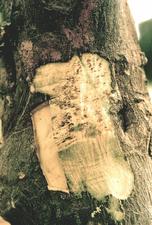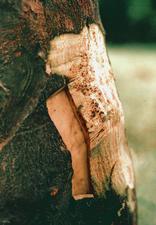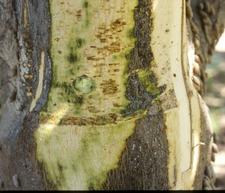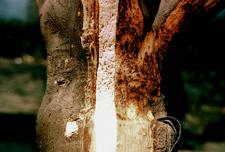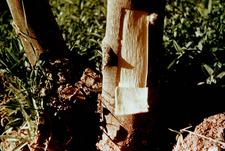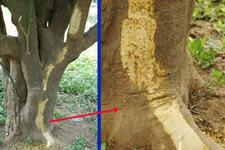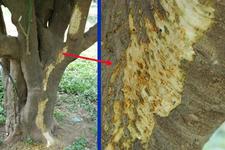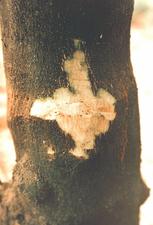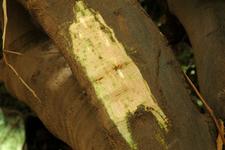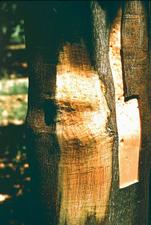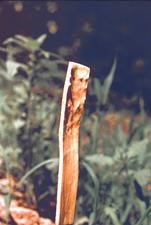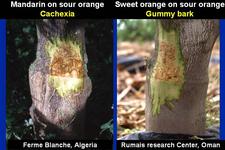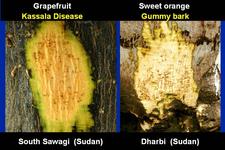Gummy Bark
HISTORY, DISTRIBUTION AND IMPORTANCE
Described in Egypt as a disorder of sweet orange trees that was first observed in 1954 during a survey conducted in the Dahala and Kharga oases in Egypt where most ‘Baladi’ sweet orange trees grafted on sour orange rootstock exhibited phloem discoloration(Nour-Eldin, 1956). Further surveys showed the same disorder affecting other sweet orange cultivars (Nour-Eldin, 1956, 1959). The disease has also been reported in a number of eastern Mediterranean, North African, Near East and Middle East countries including Egypt, Greece, Iran, Iraq, Pakistan, Syria, Lybia, Sultanate of Oman, Saudi Arabia, Yemen, Sudan and Turkey but never from North and South America (Bové, 1995).
NAME OF DISEASE AND SYNONYMS
Phloem discoloration of sweet orange (Nour-Eldin, 1956). Gummy bark (Nour-Eldin, 1968).
Abbreviation: GB for Gummy bark.
SYMPTOMATOLOGY
General aspect of affected field tree
Diseased trees are usually moderately stunted.
Symptoms on trunk (on rootstock and/or scion), limbs and shoots
Scraping the bark of the trunk, show streaks of reddish-brown gum impregnated tissue, particularly near the bud union (GB. 01, 02, 03, 04). In severe cases, the discoloration may extend above the bud union affecting the trunk and even the main branches (GB. 05, 07, 08). In mild cases (GB. 10), gumming is restricted to the bud union (GB. 09). Bark discoloration does not extend to the sour orange rootstock (GB. 01, 03, 07). Removal of a piece of bark across the bud union is required to see pitting of the wood of sweet orange. Two types of pits have been observed; one type presents a grooved or channeled appearance to the cambial face of the wood (GB. 06), whereas the other type is round and conoid (GB. 05). Gum impregnates the inner tissue of the pegs (GB. 02, 05). After bark removal, the stem pitting observed in affected trees resembles those of cachexia on cachexia-sensitive hosts and those pf Kassala disease of grapefruit.
Rough lemon is also susceptible (Nour-Eldin, 1968). Sweet orange trees grafted on rough lemon exhibiting gummy bark symptoms in the sweet orange scion also show bark pegging and gumming, and stem pitting on the rootstock, as well as bud-union crease (Bové, 1995). The amount of gum in the sweet orange bark above the bud union can be considerable and, in such cases, bark scaling is observed (Bové, 1995).
Symptoms on leaves
No specific symptoms.
Symptoms on fruit
None.
Histological and cytological symptoms
None described.
CAUSAL AGENT: DESCRIPTION AND PROPERTIES
According to Nour-Eldin, the causal agent is graft-transmissible (Nour-Eldin, 1968), and the disease was considered to be caused by a virus. However, following the discovery that the cachexia disease was caused by a viroid (Semancik et al., 1988), the hypothesis that the gummy bark disease might be also caused by a viroid gained popularity. This hypothesis was compatible with indirect evidences such as (i) symptoms that are virtually identical to those of cachexia disease on cachexia-sensitive hosts and (ii) the geographical distribution of the disease which has only been observed in countries where high temperatures favour viroid symptom expression. All symptomatic trees from Turkey, Egypt and the Sultanate of Oman tested have been found to be infected with Citrus exocortis viroid (CEVd), Hop stunt viroid (HSVd), Citrus viroid III (CVd-III) recently renamed Citrus dwarfing viroid (CDVd) and Citrus viroid IV (CVd-IV) recently renamed Citrus bark cracking viroid (CBCVd) (Önelge et al., 1996; Bernad et al., 2005). Following the finding that HSVd variants inducing cachexia differed from non-cachexia variants in only 5-6 nucleotides located in the V domain (Reawarakorn and Semancik, 1998), the hypothesis that additional variants of HSVd might cause gummy bark was entertained. However, molecular characterization of HSVd variants present in gummy bark sources from Turkey did not allow identification of a distinct variant associated with gummy bark affected trees (Önelge et al., 2004). At present the causal agent is still unknown.
HOST RANGE
Thus far, restricted to Citrus spp.; non-rutaceous hosts: unknown.
Sensitive species, varieties or combinations
Sweet orange and Rough lemon.
Symptomless species, varieties or combinations
· Immune: none described
· Tolerant (symptomless carrier): Sour orange, Mexican lime, grapefruit, willowleaf mandarin, Orlando tangelo, trifoliate orange and the citrange hybrids, Citrus amblicarpa, Rangpur lime and lemon.
TRANSMISSION
Natural
Cultural transmission through budwood.
No evidence for vector transmission.
Experimental
Graft inoculation with shoots, buds, bark from shoots.
Mechanical transmission: not reported.
EPIDEMIOLOGY
Not studied.
DIAGNOSIS
Diagnostic field symptoms
Scraping the bark of the sweet orange trunk above the bud union reveals gum deposits (GB. 01, 02, 03, 09, 10). After bark removal across the bud-union, stem pitting is observed.
Comparison with other diseases
The gummy bark symptoms on sweet orange resemble those of cachexia on mandarin (GB. 14) and those Kassala disease on grapefruit (GB. 15).
After bark removal, affected trees show stem-pitting symptoms (GB. 05, 06, 12, 13) resembling those of cachexia on cachexia-sensitive hosts. However, Nour-Eldin (1968) reported that graft transmission of gummy bark sources to sweet orange grafted on tangelo Orlando resulted in the development of symptoms on the sweet orange scion in the absence of cachexia symptoms on the Orlando tangelo stock. He, thus, concluded that the two diseases were not caused by the same agent.
Biological indexing
· Indicator plant and inoculum: Sweet orange on sour orange rootstock. Two inoculum bark patches are grafted on the sweet orange scion. Alternative indicators: Sweet orange on rough lemon rootstock.
· Observed symptoms: A line of reddish-brown gum impregnated tissue just above the bud-union of sweet orange on sour orange. Sweet orange on rough lemon develops the same brownish streak at the bud-union but with the formation of a continuous series of pegs at the bud-union forming a bud-union crease.
· Incubation and development of symptoms: In the case of sweet orange on sour orange, symptoms appear after 4-5 years. Sweet orange on rough lemon develops the symptoms in about 3 years. The indicator plants should be grown in a field plot receiving the best agricultural practices for vigorous growth.
Serological and molecular diagnostic methods
None available.
CONTROL
Use of gummy bark – free budwood.
SELECTED REFERENCES
Bernad, L., P. Moreno, J.M. Bové, N. Duran-Vila (2005) Viroids in Gummy bark sources from the Sultanate of Oman. p. 272-279. In: N. Duran-Vila, M. Hilf, M. Peña-Rocha (Eds.) Proc. 16th Conf. Intern. Organization Citrus Virol. IOCV, Riverside, CA.
Bové, J.M. (1995). Virus and virus-like diseases of citrus in the Near East region. FAO, Rome. 518 pp.
Nour-Eldin, F. (1956). Phloem discoloration of sweet orange. Phytopathology 46: 238-239.
Nour-Eldin, F. (1959). Citrus virus research in Egypt. In: Citrus virus diseases, 219-227. Berkeley, Div. Agric. Sci. Univ. Calif. Berkeley, CA.
Nour-Eldin, F. (1968). Gummy bark of sweet orange. In: Indexing procedures for 15 virus diseases of citrus trees, 50-53. Agricultural handbook No. 33. Washington, D.C., Agr. Res. Service.USDA.
Önelge, N., A. Çinar, U. Kersting, J.S. Semancik (1996). Viroids associated with Citrus Gummy bark disease of sweet orange in Turkey. p. 245-248. In: J.V. da Graça. P. Moreno, R.K. Yokomi (Eds.) Proc. 13th Conf. Intern. Organization Citrus Virol. IOCV, Riverside, CA.
Önelge, N., A. Çinar, J.S. Szychowski, G. Vidalakis, J.S. Semancik (2004). Citrus viroid II variants associated with ‘Gummy Bark’ disease. Eur. J. Plant Pathol. 110: 1047-1052.
Reanwarakorn K., J.S. Semancik (1998). Regulation of pathogenicity in hop stunt viroid-related group II. J. Gen. Virol. 79: 3163-3171.
Semancik, J.S., C.N. Roistacher, R. Rivera-Bustamante, N. Duran-Vila (1988). Citrus cachexia viroid, a new disease of citrus: Relationship to viroids of the exocortis disease complex. J. Gen. Virol. 69: 3059-3068.
Prepared (1980) by F. Nour-Eldin
Faculty of Agriculture
University of Lybia
TRIPOLI,
(Lybia)
Revised and updated (2008) by N. Duran-Vila1 and J.M. Bové2
1Centro de Protección Vegetal y Biotecnología
Instituto Valenciano de Investigaciones Agrarias
Apartado oficial 46113 MONCADA (Valencia)
(Spain)
2IBVM, Laboratoire de Biologie Cellulaire and Moleculaire,
I.N.R.A./ Université de Bordeaux 2,
Centre INRA de Bordeaux,
71, Ave. E. Bourleau,
33883 – Villenave d’Ornon,
(France)
Click any image to see larger.
PHOTOS |
LEGENDS AND AUTHORS |
|---|---|
|
Gummy bark affected sweet orange on sour orange. Notice gum impregnated bark tissue and wood grooving above bud-union, whereas sour orange bark is free of gum. (Lybia) – J.M. Bové
|
|
|
Same as GB. 01. Notice gum deposit in section of orange bark. (Lybia) – J.M. Bové
|
|
|
Gummy bark affected sweet orange on sour orange. Notice gum impregnated bark tissue above bud-union, whereas sour orange bark is free of gum. (Sultanate of Oman) – J.M. Bové
|
|
|
Same as GB. 03. Notice gum deposit in section of orange bark. (Sultanate of Oman) – J.M. Bové
|
|
|
Gum or discoloration may extend 60 cm or more above the budunion in the bark of the trunk and main limbs of the sweet orange. Bark discoloration does notr extend to the bark tissues of the rootstock. Notice also wood pitting of the round conoid type, only above the budunion. (Egypt) – F. Nour-Eldin
|
|
|
Gummy bark affected sweet orange: wood pitting giving grooved or channelled appearance to the cambial face of the wood. (Egypt) – F. Nour-Eldin
|
|
|
Severely affected sweet orange tree with gum impregnated bark tissue above bud-union. (Sudan) – N- Duran-Vila
|
|
|
Same tree as in GB. 06 showing that gum impregnated bark tissue extending up to the main branches. (Sudan) – N- Duran-Vila
|
|
|
Mild case of gummy bark: gum in sweet orange bark is almost exclusively restricted to budunion line. (Lybia) – J.M. Bové
|
|
|
Mild gummy bark symptoms in sweet orange. (Sudan) – N- Duran-Vila
|
|
|
Budunion constriction on gummy bark infected sweet orange tree grafted on rough lemon rootstock. (Egypt) – F. Nour-Eldin
|
|
|
Valencia sweet orange of Egyptian origin on sour orange. Only sweet orange scion shows gum impregnation of bark and stem pitting. Bark has been scratched below and above budunion to show gum in bark. Bark removal reveals stem pitting (Antalya, Turkey) – J.M. Bové
|
|
|
|
|
|
Strip of bark from the tree in GB. 12. Note gummy bark stem pitting on sweet orange bark above budunion line (Antalya, Turkey) – J.M. Bové
|
|
|
Symptoms of cachexia on mandarin grafted on sour orange (Ferme Blanche, Algeria) and symptoms of gummy bark on sweet orange grafted on sour orange (Rumais Research Center, Sultanate of Oman) – J.M. Bové
|
|
|
Trunk of a Foster grapefruit affected by severe Kassala disease. (South Sawagi, Sudan) and symptoms of gummy bark on sweet orange (Dharbi, Sudan) – N. Duran-Vila
|

